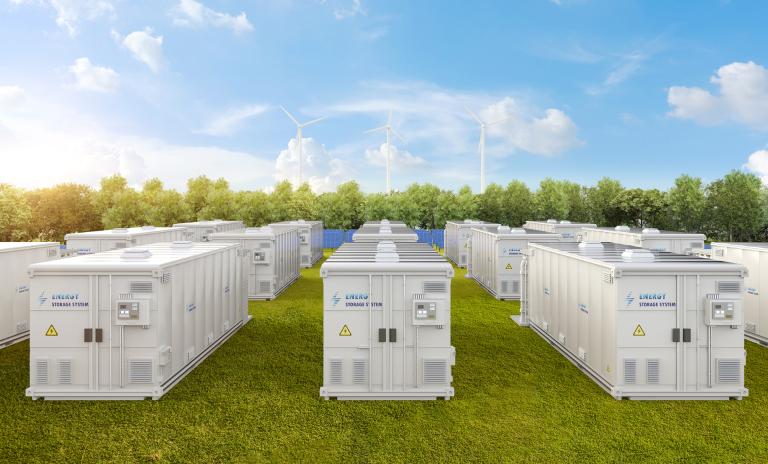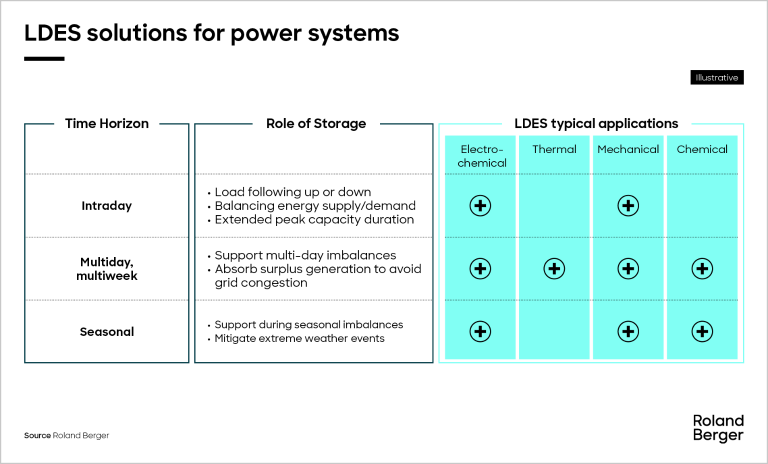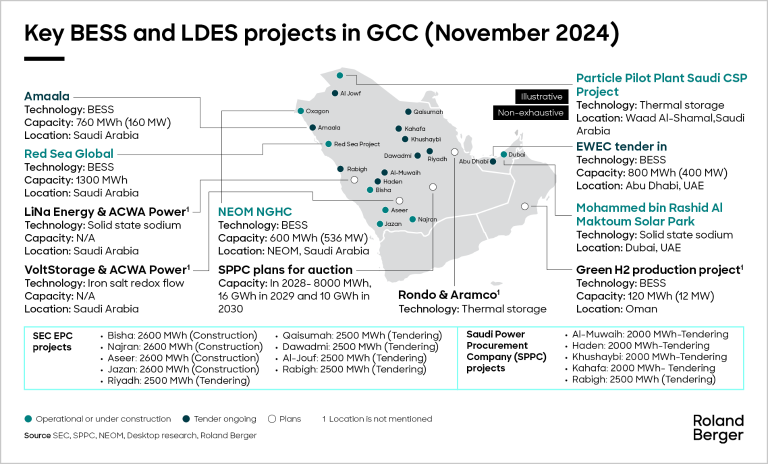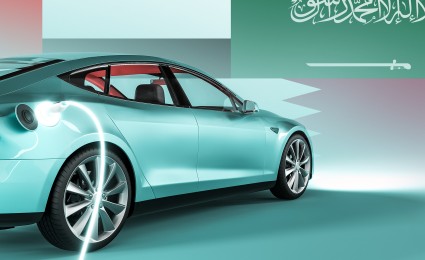Explore how hydrogen can drive decarbonization in the maritime sector. Discover the Middle East's potential as a clean bunker hub for sustainable shipping.


Accelerating long duration energy storage (LDES) in the GCC – a call to action
The crucial role of LDES
The energy landscape in the Gulf Cooperation Council (GCC) is undergoing a significant transformation, as countries across the region diversify their energy sources and reduce their reliance on fossil fuels. For example, Saudi Arabia aims to generate 50 percent of its energy from renewable sources by 2030, primarily through large-scale solar and wind projects. Similarly, the United Arab Emirates (UAE) plans to increase the role of clean energy in its power system, targeting 44 percent of the country’s energy mix from renewables by 2050. Qatar, a global leader in natural gas production, is also embracing renewables; it has set a goal of 20 percent of its electricity coming from renewable sources by 2030.

However, the growing share of variable renewable energy (VRE) in the power mix brings with it new challenges. The intermittent nature of VRE output, dependent on real-time resource availability, can cause fluctuations in energy supply, leading to mismatches with power demand.
Long-duration energy storage (LDES), typically defined as energy storage technologies capable of storing energy for more than six hours, can become one of the key solutions to this challenge, acting as a shock absorber between fluctuating load requirements and variable energy supply, and thereby enhancing the reliability and stability of the grid.
The idea of long-duration energy storage (LDES) is not new: Pumped hydroelectric storage was introduced as far back as 1907. Over the past decades, however, significant advancements have been made in other LDES technologies.
Globally, the use of LDES has grown significantly in recent years, and this trend is now expected to accelerate – most studies concur that when VRE penetration reaches 50 percent, the required energy storage capacity should be close to 20 percent of peak power demand. According to the latest data from the LDES Council, 110-115 GW of capacity is currently either announced or operational worldwide. Based on the current pipeline, LDES deployment is projected to reach approximately 222 GW in global capacity by 2035 (Fig. 1) – a growth trajectory that falls considerably short of the estimated 8 TW required by 2040 to achieve global decarbonization goals.

"LDES is a crucial solution for variable renewable energy, enhancing grid reliability and stability as GCC nations shift significantly towards renewable sources"
LDES technologies and use cases
The term “LDES” covers a wide range of technologies designed to store energy in different physical forms over extended periods. These technologies include thermal, electrochemical, mechanical and chemical storage methods, providing versatile solutions to meet a wide range of energy storage needs:
Electrochemical storage comprises batteries with varied chemical compositions that store and release energy. This category includes flow batteries, metal anode batteries and hybrid cathode batteries. Electrochemical systems are prized for their flexibility and extensive operational range, making them suitable for a wide array of applications.
Thermal storage captures and retains energy by heating or cooling a medium, which can later be converted back into electricity or used directly for heating. Key technologies in this category include sensible heat, latent heat and thermochemical storage. Thermal storage systems are valued for their resilience against degradation, their modularity and their ability to cycle throughout the day.
Mechanical storage involves storing potential or kinetic energy to be released as needed. This includes advanced technologies such as pumped storage hydropower (PSH), gravity-based systems and liquid CO2 storage, known for their established reliability, safety and low operating costs.
Chemical storage involves converting and storing energy in chemical bonds. The energy can later be released through controlled chemical reactions to generate power. Techniques include hydrogen storage, synthetic fuels and ammonia-based systems. Chemical storage has high energy density and long-term storage capabilities.
Use cases for LDES are expected to focus on critical tasks such as energy shifting, providing solutions ranging from hourly to weekly and seasonal durations, grid services such as capacity provisioning, and optimizing transmission and distribution networks in large-scale power systems.

In addition, LDES can provide specific solutions. Thermal LDES, for example, can store energy as heat, enabling the cogeneration of heat and power. This technology has significant potential to supply heat to industrial customers and communities, especially in regions with limited grid access that rely heavily on fossil fuels.
Challenges and current applications
At present, most LDES technologies are at an early stage of development, lacking technological maturity and facing various challenges to their broader adoption. On the commercial side, challenges include high upfront installation and integration costs for LDES systems, competition with established energy storage forms (such as short-duration batteries, which are cheaper and more mature) and uncertainty around wholesale market revenues for technologies. In terms of technical challenges, LDES suffers from limited data on their long-term performance, long-term durability and maintenance needs, and potentially technical limitations for applications requiring high ramp rates.
To overcome these challenges, sustained research and development efforts will be crucial. Investing in innovation will enhance the efficiency, scalability and cost-effectiveness of LDES technologies, making them more competitive with established energy storage solutions.
Initiatives and applications in the GCC
Currently, only a few energy storage projects are operational in the GCC, the majority in the UAE and Saudi Arabia. But things are set to change, with many more projects planned or already under construction (Fig. 3). By 2030, GCC could become a leader in deploying battery energy storage systems (BESS). For example, Saudi Arabia’s grid-scale BESS market is expected to become the third largest in the world.
While lithium-ion BESS technologies still dominate in the market, their limitations – particularly in high-temperature environments – make them less suitable for the GCC region’s specific needs. This gives long-duration energy storage technologies an opportunity to capture a substantial share of the future GCC market. Recognizing this opportunity, leading companies across the GCC have started investing and partnering with LDES system developers. For instance, ACWA Power has partnered with VoltStorage, a German innovator specializing in flow batteries, to advance energy storage solutions. Additionally, Saudi Aramco has invested in thermal battery storage solutions by partnering with Rondo Energy, signing a Memorandum of Understanding (MoU) for installations totaling up to 1 GWh. However, there remains much to be done.

"By investing in LDES, not only can GCC nations accelerate their own transition to sustainable energy, but also shape the future of global energy storage, solidifying their role as leaders in the next era of energy"
A call to action
Despite potentially critical levels of demand in the future, no one country or region has yet emerged as the global leader in LDES technology. This presents a unique opportunity for GCC countries to take pole position in manufacturing and innovation. By seizing the moment, not only can GCC nations accelerate their own transition to sustainable energy – they can also shape the future of global energy storage, solidifying their role as leaders in the next era of energy innovation.
GCC governments and key private sector players can take various steps to foster an environment conducive to LDES:
- Provide financial incentives and supportive policies: Regulators and governments should consider reducing financial barriers by offering grants, subsidies or direct funding to companies developing or deploying LDES technologies. Implementing supportive policies will further encourage innovation and investment in the sector
- Establish innovation hubs and research collaborations: Creating dedicated research centers or pilot projects focused on LDES technologies can foster collaboration between academia, industry and government, promoting technological advancements and innovation
- Facilitate market access and support scaling: By signing long-term offtake agreements, governments and key industry players can ensure a stable market for domestically developed LDES technologies. Deploying and rigorously testing these technologies will support their scaling and commercial viability
- Invest in companies and manufacturing facilities: Investors need to back developing companies and innovative ventures, fueling the advancement of new energy storage solutions and supporting the creation of local manufacturing facilities
- Standardize regulations: Establishing industry-wide standards for safety, efficiency and performance will encourage broader adoption and investment in energy storage solutions, ensuring reliability and trust in the technologies
At Roland Berger, we offer extensive expertise in the field of LDES, backed by a proven track record of collaborating with startups, investors, policymakers and energy companies globally and regionally. Our tailored solutions include providing market studies to deliver insights into the value chain and market economics of LDES, developing investment strategies across geographies and value chain segments, and offering actionable recommendations on deal structures, partnerships, joint ventures and policy requirements for LDES adoption.









